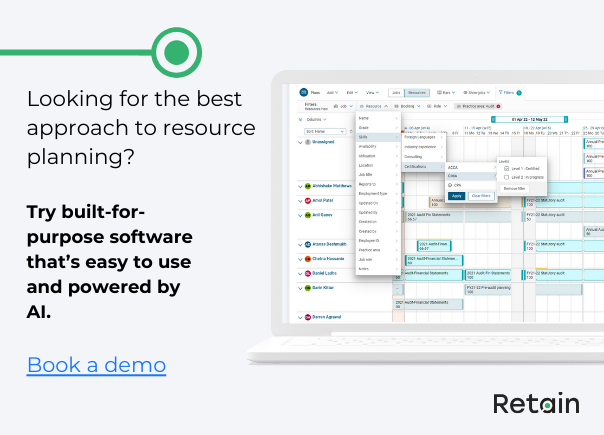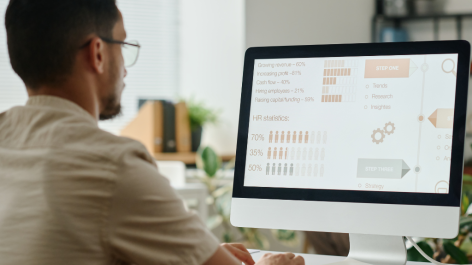For companies seeking efficient and integrated solutions, Enterprise Resource Planning (ERP) softwares have become indispensable. In this article, we share the latest ERP statistics, shedding light on key factors such as industry adoption, implementation success rates, ROI timelines, and common obstacles faced along the ERP journey.
Whether you’re considering your first ERP solution, or looking to optimise your existing system, these ERP statistics should help you to make the best decisions for your business. Let's get into them.
Or if you’re ready to skip all the details and get stuck into levelling up your organisation with resource scheduling technology, then Retain has you covered. Our specialist software streamlines all aspects of resource management.

ERP market statistics
Resource planning and management systems like ERP, are a crucial systems for businesses, driven by factors like the widespread adoption of digital technology, thriving global trade, and the need to effectively manage and analyse large volumes of data. Market statistics reveal the growing popularity and global demand for ERP solutions.
1. The ERP market is experiencing rapid expansion and the market is projected to reach $117.09 billion by 2030, growing at a CAGR of 10.0% from 2021 to 2030.
2. The global ERP software market is expected to grow to 1,266 billion by 2028 at a CAGR of 15 percent.
3. ERP revenue increased across all sectors, with administrative ERP, financial management software (FMS), and human capital management (HCM) experiencing strong growth rates of 7% and 10%, respectively.
4. According to the same above study, in North America, the ERP market is valued at over $10 billion
5. The Asia-Pacific region is an emerging market expected to achieve a compound annual growth rate (CAGR) of 13.2% until 2026.
6. Globally, the ERP market is projected to grow at a CAGR of over 8.1% over the next five years.
7. According to a survey of IT decision-makers, 53% of respondents consider ERP as a priority investment, alongside customer relationship management (CRM).
8. Additionally, 50% of companies are planning to acquire, upgrade, or update their ERP systems in the near future.
9. Given these trends, the global ERP software market is expected to reach an impressive $78.4 billion by 2026.
ERP usage statistics
When it comes to ERP, some resource management software features are considered more important than others. Let's take a look at some interesting facts about ERP usage:
10. Manufacturing companies rule the ERP game as the top users of ERP software.
11. In a survey of 255 companies planning to buy ERP software: 89% said accounting is the most crucial ERP function. Inventory and distribution were also high on the list at 67%, followed by CRM and sales at 33%, and technology at 21%.
12. Manufacturers took the lead, making up a big chunk of 47% of the companies interested in getting ERP software. Distribution companies came in second at 18%, with services trailing behind at 12%.
13. Most ERP users (84%) expected to spend less than 2% of their annual income on ERP.
14. When asked why they implemented an ERP system, 40% of companies said they wanted better functionality.
15. The main decision-makers in ERP software purchases were employees from finance and accounting (23%) and the IT department (23%).
16. Small businesses with 50–99 employees also had a strong opinion. A whopping 57.5% strongly agreed to invest in cloud and hosted solutions.
17. According to Statista, the worldwide expenditure on digital transformation is expected to reach $3.4 trillion by 2026.
ERP implementation statistics
Let's dive into some interesting stats about ERP implementation:
18. 30% of businesses choose ERP software for better financial management.
19. According to more than 30% of businesses, the top reason for implementing an ERP system is to support growth. Followed by greater functionality (20%), increased efficiency (13%), and consolidating systems (12%).
20. In a 2019 survey of distributors and manufacturers, 67% described their implementations as successful or very successful.
21. Those who had very successful implementations attributed it to internal factors like strong management support, effective change management programs, and thorough due diligence.
22. When things didn't go as planned during implementation, only 12% of respondents pointed to poor software quality as the issue.
23. The top two problems during implementation were inadequate testing and insufficient business process reengineering.
24. After ERP implementation, 49% of companies reported improvements in all their business processes. Only a small 5% said they didn't see any improvements.
25. In a survey of ERP implementation, midsize companies with $100 million to $250 million in revenue had the fastest implementations, taking around 6.6 months. On the other hand, very large companies with over $25 billion in revenue took the longest at an average of 12.35 months.
26. When it came to customisation needs during implementation:
- 10% of respondents required minor customisation.
- 33% needed some level of customisation.
- 37% required significant customisation.
27. In terms of staying on schedule, nearly half (49%) of the companies that underwent ERP implementation went live within the allocated time frame. Among them, 13% even managed to go live sooner than expected. However, 27% experienced a slight delay, while 11% failed to meet the scheduled go-live date.
28. The main reasons companies went over budget during implementation is due to the expansion of the initial project scope.
29. According to 46% of organizations, ERP projects are implemented on budget, and 38% say it was completed with slightly more cost than anticipated. Of those who went over budget, the most common reasons were underestimating project staffing (38%), initial project scope expansion (35%), and technical and data issues (34%).
ERP ROI statistics
Let's explore some interesting ERP return on investment (ROI) statistics:
30. On average, companies saw a return on their ERP investment in a little over 2.5 years. It's a long-term gain that pays off.
31. ERP implementation has proven to improve business processes for 95% of companies.
32. In a study of ERP implementation, 85% of companies had a projected timeline for ROI. Among them, 82% achieved ROI within their expected timeframe.
33. The top three benefits reported by businesses after implementing ERP are reduced process time, increased collaboration, and a centralised data system. These improvements contribute to smoother operations and better teamwork.
34.The primary goals for implementing ERP include cost savings (46%), improved performance metrics (46%), and enhanced efficiencies in business transactions (40%). It's all about maximising resources and optimising operations.
35. The areas where ERP delivers ROI include reduced IT costs (40%), decreased inventory levels (38%), and shorter cycle times (35%). These outcomes help companies save money, manage inventory better, and speed up processes.
36. For midsize companies with revenue under $1 billion, the cost of owning an ERP system typically amounts to around 3-5% of their annual revenue.
37. Large companies with revenue over $1 billion can expect the cost of owning an ERP system to be approximately 2-3% of their annual revenue.
Cloud technology statistics
38. According to Forrester, cloud subscriptions for business applications were estimated to generate $170 billion in revenue in 2020.
39. Cloud-based ERP systems experienced a growth rate of 20.7% in enterprise applications within the public cloud in 2018.
40. An international survey revealed that 64% of companies use Software-as-a-Service (SaaS) for their ERP needs, 21% opt for cloud ERP, and only 15% rely on on-premises solutions.
41. Among the survey respondents in the manufacturing and distribution sectors, 44% reported using cloud deployments for their ERP implementations.
42. In 2022, global spending on cloud applications reached $226.9 billion, while cloud platform services were expected to reach $70 billion.
ERP future trends statistics
As businesses face increasingly intricate requirements, ERP software is evolving to cater to the need for greater flexibility and enhanced integration with social platforms. Current trends in ERP reflect a shift towards embracing cloud-based solutions and intelligent systems that streamline and automate operations.
43. In the UK, 53% of CIOs are actively seeking more advanced ERP systems that incorporate cutting-edge technologies such as machine learning, artificial intelligence (AI), and automation.
44. These forward-thinking leaders recognise the potential of predictive analytics and deep learning as crucial ERP technologies to gain a competitive edge.
45. Additionally, 15% of organisations are planning to increase their budget allocation for the Internet of Things (IoT), indicating a growing recognition of its importance in ERP implementations.
46. Furthermore, the demand for personalised experiences across ERP systems is driving 82% of UK CIOs to choose ERP solutions that offer customisation options or leverage user interface (UI) overlays. This emphasis on tailoring ERP systems to specific needs highlights the desire for a more user-centric approach.
47. 80% of developers believe most ERP processes can be completely replaced by machine learning or AI.
Are there any ERP challenges to consider?
ERP implementations often encounter common challenges that can hinder their success. These include inadequate project management, difficulty in managing implementation costs and timeline, internal resistance to change, integration problems with other software systems, and issues with data quality.
These challenges arise when ERP implementation goals aren’t clearly defined, the wrong ERP vendor is chosen, or the purchased software doesn’t align with the company's needs.
While an ERP system can greatly benefit your business, it’s crucial to select the right platform and assemble a competent implementation team to avoid becoming another unfortunate statistic in the world of ERP.
Research conducted over the years reveals some concerning statistics about ERP implementations:
48.Approximately 51% of companies experience operational disruptions when going live with an ERP system.
49. Around 50% of ERP implementations fail in their initial attempt.
50. Implementation duration tends to be 30% longer than anticipated.
51. The cost of implementation often exceeds the initial budget by three to four times.
52. The need for system modifications to enhance usability leads to overspending in 65% of cases.
53. 64% of ERP projects will spend more than the allotted budget.
54. The three areas where ERP systems often fall short for users are data accuracy, user experience, and analytics.
Choosing the right ERP solution
As you may have gathered from these ERP statistics, the most popular ERP solutions provide a comprehensive range of services that for all the essential aspects of enterprise operations, including accounting and human resources.
However, they go beyond the basics by offering a diverse array of applications that cover various areas such as CRM (customer relationship management), HCM (human capital management), PLM (product lifecycle management), SCM (supply chain management), WMS (warehouse management systems), and more.
Forward-looking organisations that embrace cloud-native ERP systems, such as Retain Cloud, that are equipped with cutting-edge technologies stand to gain numerous benefits, including improved efficiencies, cost savings, and rapid deployment.
With cloud deployment becoming increasingly accessible, ERP software is now within reach for organisations of all sizes, catering to the needs of both large enterprises and small businesses that are experiencing rapid growth.


